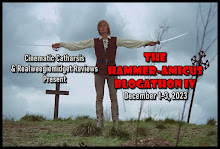Does the World really need another book about Hammer movies?
Since the mid-1990s hardly a year has gone by without the release of at least one publication dedicated to the history of Britain’s most influential horror film studio. We had gloriously produced general overviews (Marcus Hearn/Alan Barnes: The Hammer Story), extensive film by film reviews of every single Hammer film production since The Public Life of Henry the Ninth from 1935 (Tom Johnson/Deborah DelVecchio: Hammer Films – An Exhaustive Filmography), two very in depth tomes about the production and release history (Wayne Kinsey’s Hammer Films – The Bray Studio Years and its follow up The Elstree Studio Years) and an accountant’s view of the company’s history (Denis “Will I ever write a book about films I actually like?” Meikle: A History of Horror – The Rise and Fall of the House of Hammer).
And these are just the good ones. On top of that there are a number of others, some good, some bad and very few plain ugly. And let’s not forget some truly excellent Hammer magazines, most notably Little Shoppe of Horrors and the now defunct Dark Terrors. [And of course Wayne Kinsey's very own The House That Hammer Built! Can't believe I forgot to mention this in my original review.]
So is there really a need to release yet another book about a studio that, though highly important, has become more of a niche interest with a very dedicated, but ultimately small number of raving fans?
Tomahawk’s new publication Hammer Films – A Life in Pictures is officially attributed to Hammer scribe Wayne Kinsey, though his actual text really plays second fiddle to this book’s ultimate raison d’être, a huge collection of ultra rare photos that Kinsey had unearthed during his research in the British Film Institute.
Hundreds of those negatives had for decades been safely stored away in the BFI’s archives, though it took a year of Kinsey’s research to identify their value and to properly attribute them to the films and the talent involved in their production. A small number of those images had subsequently been exhibited at the BFI South Bank, but it is safe to say that the vast bulk of those photos have never been seen up to the release of this book.
The majority of those are black and white pictures, though the book also has 16 pages of coloured prints. Apart from simply being able to see some very rare pictures of Hammer productions, there are another two reasons why this book should prove fascinating for every Hammer - but also general Brit Horror - Fan.
First of all it is important to notice that every film production was invariably accompanied by a photographer who captured the atmosphere on set. In contrast to most other books about the studio, this means that its famous horror movies are not the only genres that are covered here. Instead the book focuses equally on all the different types of projects that Hammer was involved in and therefore covers Hammer Noir as well as the Frankenstein, Dracula and general Horror films and also its forays into Science Fiction, Psychological Thrillers, Drama, War, Fantasy, Comedy and Swashbuckler productions. Very few other books have ever given equal coverage to all those genres when dealing with its subject.
Secondly, it is quite obvious that a large number of those images were not necessarily intended for publicity purposes, so even though we have a good number of glamour shots or star photography, we also have a very large chunk of on set photography giving us all a good idea of Hammer as a truly “working” production company.
It was fascinating watching the crews at work and play. I had previously heard about the accident that caused the ship to capsize during the filming of The Devil Ship Pirates, though now was able to actually view what happened. Amazing to see how some utterly crazy and dangerous stunts were filmed. (Not a good idea to really have a noose around your neck while you’re sitting on a bolting horse.) And nothing demonstrates the joviality and camaraderie on set better than a tombstone saying “Alfred Hitchcock R.I.P” designed for ex-Hitchcock Blonde Joan Fontaine during The Witches’ shooting.
All in all, this is a gorgeous piece of cinema history, an absolute Must Have for everyone only remotely interested in the history of Hammer or Brit Horror in general and, as this is strictly limited to 2500 copies, something you may want to quickly arrange as a Christmas present for either yourself or your loved ones.
PLAGUE OF THE ZOMBIES (John Gilling, 1966)
-
A gang of ruffians and a rash of mysterious deaths frighten villagers into
a malignant malaise, fearing bubonic consequences and bombastic
recriminati...
1 year ago

























1 comment:
This is possibly my favourite Hammer book ever. Seriously, I am such a Hammer geek I just about cried when I started reading it. It was like unearthing my family history or something, so important has Hammer been in my life since I was a kid. I love how much detail Kinsey went into in identifying the people in the pictures. Utterly brilliant.
Post a Comment